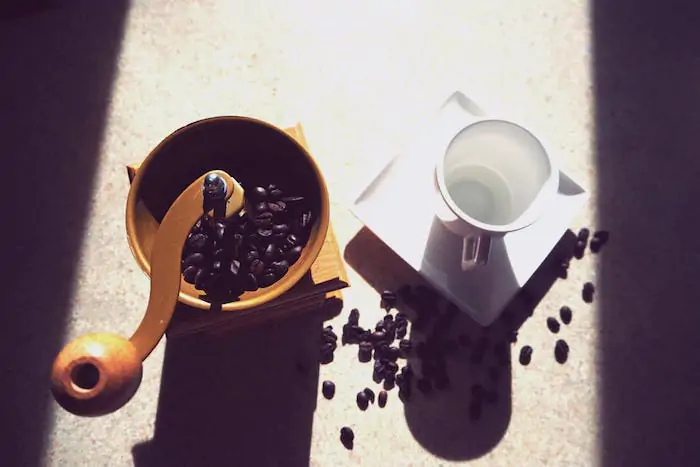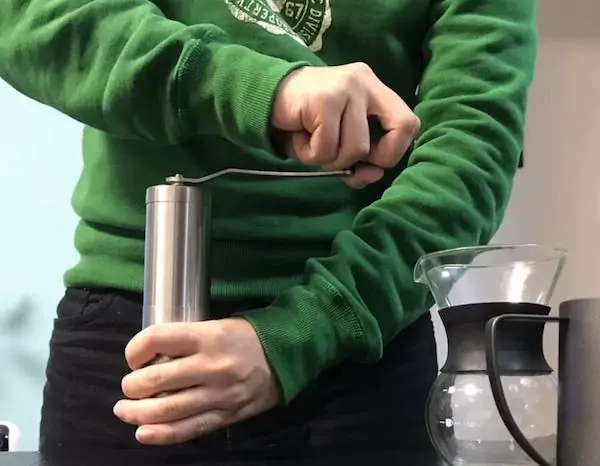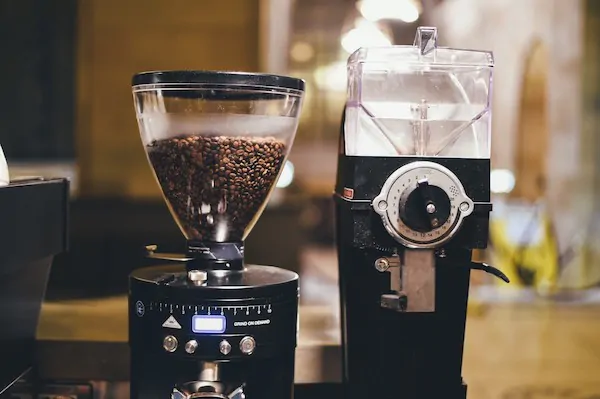A good coffee grinder cost is based on the materials used and the available features. Find out how much you should pay for a good-quality coffee grinder.

Grinding coffee beans is the first step of every brew cycle. And in order to get the best brew, you need to use a great coffee grinder.
I love my cheap grocery store grinder, but it’s getting old, and I’ve been shopping for a replacement. For me, the main question is whether I can get a good grinder at a reasonable price.
How much does a coffee grinder cost? Most coffee grinders cost somewhere between $20 and $70. Decent burr grinders designed for home brewing usually cost around $35.
The quality of your grinder will impact the texture of your coffee beans and the taste of your final brew.
The coffee grinder that you choose says a lot about your coffee-making preferences. Pick your favorite style, and look for a design with good features and a reasonable price.
What You Can Expect To Pay For A Coffee Grinder
Coffee grinders usually cost between $20 and $70. However, you can frequently find excellent grinders that cost as little as $10, and there are expensive grinders sold for as much as $150. The price you pay will determine unique features and the quality of your grind.
$10-$20
The cheapest types of coffee grinders (see my favorite one) are blade grinders with simple electric motors. These grinders make a lot of noise and don’t always produce a consistent grinder. However, they do a fine job of breaking down your beans and can be relied on for a delicious cup of coffee.
Depending on where you look, you might be able to find a manual burr grinder at this price point. However, the parts may be low-quality, and you should expect the grinder to have a shorter lifespan.
$20-$50
Most good coffee grinders can be found at a mid-level price point. The parts needed to make a coffee grinder are easy to produce, so even high-quality designs can be produced for a surprisingly affordable cost.
At this price level, expect good quality materials and a blade that will keep grinding for years. You can find many different features at this price point, so shop around for different burr shapes and speed settings. Like any kitchen appliance, check your grinder for good construction before you make your purchase. You can have a look at my favorite coffee grinders here.
$50-$100
High-end coffee grinders usually cost less than $100. If you buy an automatic grinder like this, you can expect to find speed and grind settings, automatic shut-off features.
Manual grinders at this price point usually have artisanal or retro designs. The extra value may come from a great appearance, a replaceable blade, or another feature that distinguishes your grinder from the pack.
$100-$200
Coffee grinders rely on a simple mechanism, so it’s difficult to design one that costs more than $80. However, if you delve into the world of high-end coffee grinders, you’ll probably find quality materials and truly automated convenience.
These grinders are typically much larger than cheaper grinders and will allow you to grind whole batches of coffee at once. Expensive grinders are often designed for coffee shops and artisanal use. Cheaper grinders may even be better for at-home brewing.
The Two Different Types Of Coffee Grinders
Coffee grinders are differentiated by the way that they grind beans. Most grinder designers use either burrs or blades to turn whole beans into coffee-ready grounds. Both types of grinders have their advantages, so which one you use is a matter of personal taste.
Blade Grinders
If you buy a cheap coffee grinder, you’ll probably end up with a simple electric blade grinder. These machines have a small bladed propeller located in the main chamber. Just add your beans, close the lid, and press a button to activate the motor. On most models, you’ll need to hold the button down until you’re done grinding.
More advanced blade grinders have different speed settings, timed grinds, and other features that can help you get a consistent texture for your coffee. The style and size of the blades will also impact the grind, so pay attention to the propeller when you make your purchase.
Burr Grinders

Burr grinders crush the coffee beans between two serrated metal burrs. Burrs can either be flat or conical, and both shapes will produce a different kind of grind.
The main feature of burr grinders is that they produce an even and consistent texture. Each piece of the coffee bean ends up roughly the same size and shape. If you use the same beans and settings, you’ll get the same grind every time.
Burr grinders are generally preferred by most coffee aficionados. They also come in a variety of different styles, and you can choose from both manual and automatic designs.
Manual Or Automatic?
The choice between manual and automatic grinding is a matter of convenience and taste. Automatic grinders take far less effort to use, but many coffee enthusiasts swear by the quality of their manual grind. The truth is that every grinder makes different coffee, and you should look for one that creates a texture you love.
Manual Grinders
All manual grinders are burr grinders. These traditional grinders work by turning a crank in order to rotate gears that are attached to the burrs. This allows you to control your speed and develop an artisanal grinding technique.
The main benefit of manual grinding is that you have complete control over the texture of the beans. You can move the crank quickly or slowly, and you can stop grinding as soon as you’re satisfied with the texture of your grounds. Manual grinders are more portable because they don’t require an electrical source.
Semi-Automatic Grinders
It’s nearly impossible to move a hand crank fast enough to make a blade grinder work, so most bladed designs rely on electric motors instead.
Most electric grinders could more accurately be referred to as semi-automatic. These grinders use an electric motor, but you still need to hold down a button to connect the circuit.
When you use a semi-automatic grinder, the consistency of your beans will be determined by how long you hold the button. Some models have different speed settings, while other designs correlate the speed of the propeller to the amount of pressure you use.
Automatic Grinders
Automatic grinders are completely self-powered and have the most advanced features. These designs include multiple speed settings and programmable grind cycles. Automatic grinders can use either burrs or blades, and some even come with swappable propellers.
Automatic and semi-automatic grinders are often placed in the same category. When you’re shopping, check to see which features the model actually includes.
Which Grinder Is Right For You?
In general, most people choose manual grinders for a simple and personal coffee experience. Manual grinders are quieter, so you never need to worry about waking up the house. Semi-automatic grinders are chosen for their speed and efficiency; anyone can use them with little effort.
Finally, automatic grinders are preferred for their unique features and high-quality designs.
| Manual | Semi-Automatic | Automatic |
|---|---|---|
| Hand-Powered | Electric | Electric |
| Quiet | Noisy | Noisy |
| Artisanal Control | Speed and Convenience | Settings and Features |
Identifying A High-Quality Coffee Grinder

Coffee grinders are a type of kitchen appliance. Grinders have internal motors, so you can compare their quality to that of a blender or stand mixer. Look for durable materials and quality construction for all moving parts.
Whether you want to buy an automatic blade grinder or a manual burr mill, run through this checklist to choose a grinder that will last you for years.
- Metal burrs or propellers
- Metal internal chamber
- Solid external construction
- Sturdy buttons or hand crank
- Simple and intuitive features
- Smooth and quiet motor
- Accessible for cleaning and maintenance
Maintaining Your Coffee Grinder
Most coffee grinders are easy to clean. After you’ve finished grinding the beans, wipe out the inner chamber with a damp paper towel or microfiber cloth. Carefully clean the burrs or propellers, and don’t forget the space just underneath the blade.
Never place an electric grinder in the sink or dishwasher. The internal motor is not waterproof, and you might experience an electrical problem the next time you plug it in. If your grinder gets, dry it off thoroughly, and wait 48 hours to use it again.
You should also never use your coffee grinder for anything but coffee. If you grind herbs or spices, you will notice those tastes in your future batches of ground beans. Purchase a different grinder for general kitchen use.
Related Questions
Are blade grinders or burr grinders better?
Burr grinders are better for taste because they grind the beans evenly and consistently. Blade grinders are more efficient, but they grind the beans into uneven pieces, and this can impact the flavor of the brew.
Can I store ground coffee for later?
Storing ground coffee for later will give your coffee a dry and bitter taste. Coffee beans start to lose flavor as soon as they’re exposed to the air. It’s fine to use pre-ground coffee if you’re worried about making noise or saving time, but don’t expect it to taste as good as a fresh grind.

